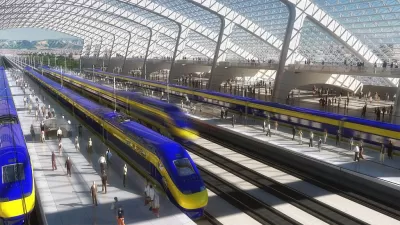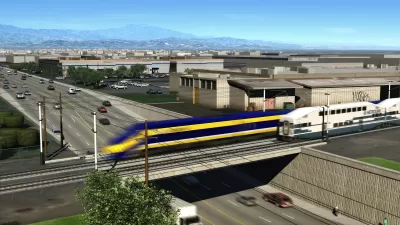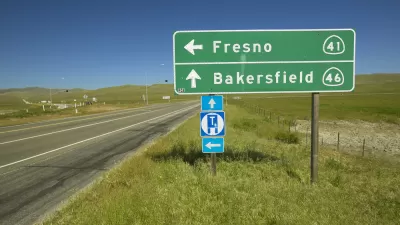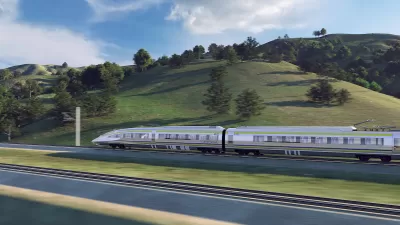The San Francisco-to-Los Angeles bullet train may have to be renamed the Central Valley High-Speed Train according to the announcement by the new governor in his first state-of-the-state address.

The California High-Speed Rail Authority broke ground in Fresno on Jan. 6, 2015 in what was thought to be the nation's first high-speed rail project. On Feb. 12, the project appears to have been dramatically downsized by Gov. Jerry Brown's successor, Gavin Newsom.
"Let’s be real. The current project, as planned, would cost too much and respectfully take too long. There’s been too little oversight and not enough transparency," Newsom said in his first State of the State Address to lawmakers on Tuesday.
"Newsom said the state will complete a 119-mile (191 km) high-speed rail link between Merced [pop. 83,000] and Bakersfield [pop. 380,000] in the state’s Central Valley," reports David Shepardson for Reuters.
“Abandoning high-speed rail entirely means we will have wasted billions and billions of dollars with nothing but broken promises, partially filled commitments and lawsuits to show for it. And by the way, I am not interested in sending $3.5 billion in federal funding that was allocated to this project back to Donald Trump."
A state audit issued in November said California’s High‑Speed Rail Authority’s “flawed decision making and poor contract management have contributed to billions in cost overruns and delays.”
Melanie Curry of Streetsblog California notes that the project, as approved by voters in November 2008, is technically not dead.
"Several news outlets have already interpreted his remarks to mean he wants to scale the project back to just the Central Valley, where construction has already begun and there are clear plans to complete the first segment," writes Curry.
But that’s not what he said. He pledged to finish the environmental work on Phase 1 of the program–which would connect San Francisco to Anaheim–and continue to pursue federal funding to complete the entire project.
Whether a "Central Valley-only" high-speed train is viable remains to be seen. But what is clear is what the new governor said: “I’m not interested in making the same old mistakes."
National implications?
The Green New Deal, introduced on Feb. 7 as House Resolution 109, calls for "overhauling transportation systems in the United States to remove pollution and greenhouse gas emissions from the transportation sector as much as is technologically feasible, including through investment in—
(i) "zero-emission vehicle infrastructure and manufacturing;(ii) "clean, affordable, and accessible public transit; and(iii) "high-speed rail;"
According to a press briefing document prepared by the two primary sponsors, Rep. Alexandria Ocasio-Cortez (D-N.Y.) and Sen. Ed Markey (D-Mass.), the proposal would "build out highspeed rail at a scale where air travel stops becoming necessary."
It was that last note that caused U.S. House Transportation and Infrastructure Committee Republicans to note "the project’s demise, tweeting that 'the plug gets pulled on the frequently delayed, over-budget San Francisco-LA (high-speed rail) project. Reality: 1, #GreenNewDeal: 0,'” adds Shepardson for Reuters.
The implications for rail travel of H.Res. 109 are included in a post on Monday, "Updated: What the Green New Deal Means for Planning."
FULL STORY: California to scale back $77 billion high-speed rail project: governor

Maui's Vacation Rental Debate Turns Ugly
Verbal attacks, misinformation campaigns and fistfights plague a high-stakes debate to convert thousands of vacation rentals into long-term housing.

Planetizen Federal Action Tracker
A weekly monitor of how Trump’s orders and actions are impacting planners and planning in America.

Chicago’s Ghost Rails
Just beneath the surface of the modern city lie the remnants of its expansive early 20th-century streetcar system.

Bend, Oregon Zoning Reforms Prioritize Small-Scale Housing
The city altered its zoning code to allow multi-family housing and eliminated parking mandates citywide.

Amtrak Cutting Jobs, Funding to High-Speed Rail
The agency plans to cut 10 percent of its workforce and has confirmed it will not fund new high-speed rail projects.

LA Denies Basic Services to Unhoused Residents
The city has repeatedly failed to respond to requests for trash pickup at encampment sites, and eliminated a program that provided mobile showers and toilets.
Urban Design for Planners 1: Software Tools
This six-course series explores essential urban design concepts using open source software and equips planners with the tools they need to participate fully in the urban design process.
Planning for Universal Design
Learn the tools for implementing Universal Design in planning regulations.
planning NEXT
Appalachian Highlands Housing Partners
Mpact (founded as Rail~Volution)
City of Camden Redevelopment Agency
City of Astoria
City of Portland
City of Laramie





























